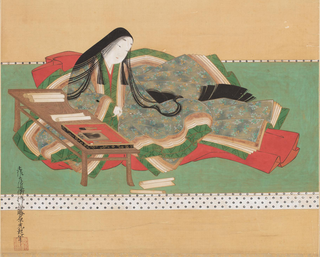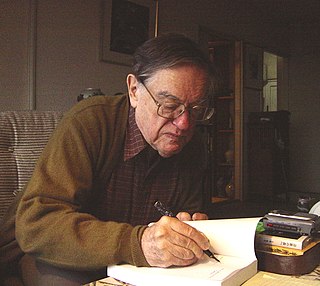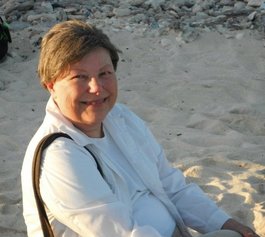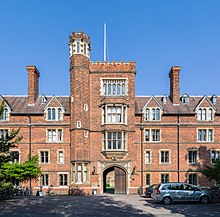
Murasaki Shikibu was a Japanese novelist, poet and lady-in-waiting at the Imperial court in the Heian period. She is best known as the author of The Tale of Genji, widely considered to be one of the world's first novels, written in Japanese between about 1000 and 1012. Murasaki Shikibu is a descriptive name; her personal name is unknown, but she may have been Fujiwara no Kaoriko (藤原香子), who was mentioned in a 1007 court diary as an imperial lady-in-waiting.

The Tale of Genji, also known as Genji Monogatari is a classic work of Japanese literature written in the early 11th century by the noblewoman, poet, and lady-in-waiting Murasaki Shikibu. The original manuscript, created around the peak of the Heian period, no longer exists. It was made in "concertina" or orihon style: several sheets of paper pasted together and folded alternately in one direction then the other.

Japanese literature throughout most of its history has been influenced by cultural contact with neighboring Asian literatures, most notably China and its literature. Early texts were often written in pure Classical Chinese or lit. 'Chinese writing', a Chinese-Japanese creole language. Indian literature also had an influence through the spread of Buddhism in Japan.

Lieutenant-General Mori Rintarō, known by his pen name Mori Ōgai, was a Japanese Army Surgeon general officer, translator, novelist, poet and father of famed author Mari Mori. He obtained his medical license at a very young age and introduced translated German language literary works to the Japanese public. Mori Ōgai also was considered the first to successfully express the art of western poetry in Japanese. He wrote many works and created many writing styles. The Wild Geese (1911–1913) is considered his major work. After his death, he was considered one of the leading writers who modernized Japanese literature.

Donald Lawrence Keene was an American-born Japanese scholar, historian, teacher, writer and translator of Japanese literature. Keene was University Professor emeritus and Shincho Professor Emeritus of Japanese Literature at Columbia University, where he taught for over fifty years. Soon after the 2011 Tōhoku earthquake and tsunami, he retired from Columbia, moved to Japan permanently, and acquired citizenship under the name Kīn Donarudo. This was also his poetic pen name and occasional nickname, spelled in the ateji form 鬼怒鳴門.

The Diary of Lady Murasaki is the title given to a collection of diary fragments written by the 11th-century Japanese Heian era lady-in-waiting and writer Murasaki Shikibu. It is written in kana, then a newly-developed writing system for vernacular Japanese, more common among women, who were generally unschooled in Chinese. Unlike modern diaries or journals, 10th-century Heian diaries tend to emphasize important events more than ordinary day-to-day life and do not follow a strict chronological order. The work includes vignettes, waka poems, and an epistolary section written in the form of a long letter.

Otogi-zōshi (御伽草子) are a group of about 350 Japanese prose narratives written primarily in the Muromachi period (1392–1573). These illustrated short stories, which remain unattributed, together form one of the representative literary genres of the Japanese medieval era.
"The Dancing Girl" was the first published short story by the Japanese writer Mori Ōgai. The story first appeared in Kokumin no Tomo in 1890, and is based on Mori's own experiences as a medical student in Germany. In some ways, this tale foreshadows Puccini's Madama Butterfly, which deals with a similar theme but with a slight role reversal: in Madama Butterfly, a Western man abandons a Japanese woman, while in The Dancing Girl a Japanese man leaves a Western woman.

Valdo H. Viglielmo was a prominent scholar and translator of Japanese literature and works of Japanese philosophy.
Peter Francis Kornicki FBA is an English Japanologist. He is Emeritus Professor of Japanese at Cambridge University and Emeritus Fellow of Robinson College, Cambridge.

Karen Brazell was an American professor and translator of Japanese literature. Her English language edition of The Confessions of Lady Nijō won a U.S. National Book Award in category Translation. She died in 2012 at the age of 73.
Edward Kamens is Sumitomo Professor of Japanese Literature at Yale University, where he has taught since 1986. His dissertation focused on the Buddhist setsuwa collection Sanbōe, and more recently he has written on allusive or intertextual language in premodern literature, particularly utamakura in waka. He was Master of Saybrook College and is now a fellow of the Whitney Humanities Center. Professor Kamens and his wife, art history professor and former Saybrook College Master and current Yale College Dean Mary Miller, are rumored to appear as extras in Indiana Jones and the Kingdom of the Crystal Skull, part of which was filmed at Yale.

Mumyōzōshi is an early 13th-century Japanese text. One volume in length, it is the oldest existing Japanese text on prose literary criticism. The author is unknown, but the leading candidate proposed is Shunzei's Daughter. Other candidates who have been proposed include her maternal grandfather Shunzei himself and the monk Jōgaku (上覚).
Vita Sexualis is an erotic novel published in 1909 by Mori Ōgai in the 7th issue of the literary journal Subaru. The protagonist of the novel, Shizuka Kanei, is understood to be a semi-fictionalized autobiographical representation of Mori Ōgai.

The Murasaki Shikibu Nikki Emaki (紫式部日記絵巻) is a mid-13th century emaki inspired by the private diary of Murasaki Shikibu, lady-in-waiting at the 10th–11th century Heian court and author of The Tale of Genji. This emaki belongs to the classical style of Japanese painting known as yamato-e, and revives the iconography of the Heian period.
Heian literature or Chūko literature refers to Japanese literature of the Heian period, running from 794 to 1185. This article summarizes its history and development.

Annie Shepley Omori was an American artist, activist, and translator. For the first fifty years of her life, she produced work under her maiden name, Annie Barrows Shepley. She studied art in New York under Harry Siddons Mowbray and in Paris at Académie Julian under Jules Joseph Lefebvre and Lucien Simon. After that, she established studios in New York and Connecticut, where she worked as a portrait painter and children's book illustrator. She married Hyozo Omori, a Japanese exchange student, in 1907 and moved with him to Japan, where they established the Yurin En settlement house to provide educational and recreational opportunities to the poor in Tokyo. They were leaders in the Japanese playground movement. Hyozo Omori died in 1913, and Shepley continued running the center. She also translated Diaries of Court Ladies of Old Japan with Kochi Doi in 1920.
Mikael "Mickey" Adolphson is a Swedish historian of medieval Japan. Adolphson is the Keidanren Professor of Japanese Studies at the University of Cambridge's Faculty of Asian and Middle Eastern Studies and a Fellow of Trinity College, Cambridge.

The Murasaki Shikibu Prize is a Japanese literary award awarded annually to an outstanding piece of literature in Japanese by a female author. It was established in 1991 by the city of Uji in Kyoto Prefecture in honor of Murasaki Shikibu's deep connection to the city of Uji. It awards a cash prize of 2 million yen, as well as a bronze statuette.
Thomas Robert Hamilton Havens is an American Japanologist.












